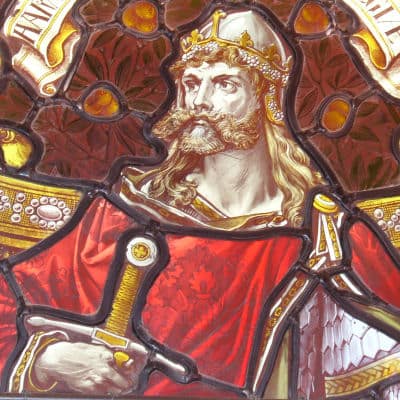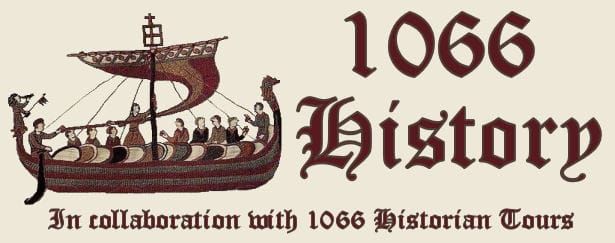Harald Hardrada was born Harald Sigurdsson,the son of Sigurd Syr and Asta Gudbrandsdatter in 1015. Through his mother, he was half-brother to Olaf Haraldsson who became King of Norway the year Harald was born. He was given the epithet Hardrada (Hard Ruler) after his death.
See Also: The Extended Family of Harald Hardrada

Early Years
Little is known of Harald’s early life but as half-brother to the king it is likely he was well educated. He was a skilled horseman and was a good fighter. It is likely that he could use the typical Norse Viking weapons – axe, spear, sword and shield.
Harald greatly admired King Olaf and would have been horrified when he was driven into exile following defeat by King Canute at the Battle of Helgea. When Olaf returned in 1028, Harald raised a force and joined his half-brother.
Olaf was determined to regain his throne. His force met that of Thorir Hund, who was loyal to Canute, at Stiklestad on 29th July 1030. Olaf was killed during the battle and Harald was wounded.

Harald Hardrada managed to escape capture and with the help of his loyal men fled to the east of Norway where he remained until his wounds healed.
Exile in Kievan Rus & Constantinople
After recovering from his wounds, Harald decided to travel to the Kievan Rus and the court of Yaroslav the Wise, where King Olaf had spent his exile years. It is believed that Harald and his men reached their destination in early 1031.
Yaroslav welcomed Harald as the brother of Olaf and gave him and his men a place in his army. It is known that Harald’s force took part in Yaroslav’s campaigns against the Poles and the Pechenegs and likely many others as well.

A few years later Harald and his force left the Kievan Rus and travelled to Constantinople, capital of the Eastern Byzantine Empire, where they joined the Varangian Guard of Michael IV. Here he took part in numerous battles against the enemies of the Empire both on sea and on land.
Michael IV died in 1041 and was succeeded by his adopted son Michael V. However, Michael IV’s wife, Empress Zoe, daughter of Constantine VIII, believed that she should be ruler. The conflict between the two made life difficult for Harald as both still wielded power.
Having been denied permission to leave the Varangian Guard, Harald and his men secretly left Constantinople and returned to the Kievan Rus.
King Canute had died in 1035 and his son, Harthacnut, had promised the throne of England to Harald’s illegitimate half-brother King Magnus the Good. However, when Harthacnut died in 1042, Edward the Confessor, son of Aethelred the Unready, had taken the throne.
Harald was now determined to return to Norway and take the crown.
Harald Hardrada King of Norway
It is believed that Harald and his men reached Sweden in 1045 and Norway the following year. Once back in Norway Harald sought an audience with King Magnus the Good and it was agreed that Harald and Magnus would co-rule.
When Magnus died on 25th October 1047, Harald became King of Norway. As King he wanted to re-unite Norway and Denmark and become King of both. However, Sweyn II, King of Denmark had the same ambition and so began a prolonged conflict between the two Kingdoms. The conflict ended in 1064 when Harald agreed to give up his claim to Denmark on condition that Sweyn recognise him as the lawful King of Norway.
Marriage and Family
During his second visit the Kievan Rus, Harald Hardrada married Elisiv of Kiev and she returned with him to Norway. They had two daughters – Ingegerd and Maria.
At some point, Harald also married Tora Torbergsdatter, possibly bigamously, who gave him two sons – Magnus II who became King on his father’s death, and Olaf III who ruled jointly with his brother on his return from fighting in England.
Invasion of England and Death
Having given up on his claim to Denmark, Harald turned his attention to the agreement made between Harthacnut and Magnus the Good. Edward the Confessor, who had become King of England in 1042, was childless and in his sixties. The time was ripe for Harald to plan an invasion of England.
In early 1066 Harald was contacted by Tostig Godwinson, the exiled brother of Harold Godwinson who had been crowned king following the death of Edward the Confessor in January 1066. Tostig and Harald agreed a joint invasion of the north of England. Harald’s second son, Olaf, joined the invasion force while his eldest son, Magnus remained in Norway.
Harald and Tostig’s force reached England in September 1066 and sailed up the river Humber towards York. On landing they defeated a Saxon force raised by the northern earls, Morcar and Edwin, at the Battle of Fulford on 20th September 1066.
Following this victory they continued to York where they received the submission of of the city.
Meanwhile, King Harold Godwinson had learned of the invasion and was on his way north with an English army. The arrival of the English army on 25th September took Harald and Tostig by surprise. They were supervising an exchange of prisoners at Stamford Bridge and were unprepared for battle. It was a hot day and many had taken off their armour and heavy weapons. In addition a large number of their men were some distance away guarding the ships which had been left on the River Ouse.

Despite being taken by surprise and ill-prepared for a fight, the battle lasted for a number of hours. This was mainly due to the fact that a single, large Viking warrior defended the bridge preventing the Saxons from crossing. This action also allowed Harald and Tostig’s army time to organise their force and form a defensive shield wall.
Soon after the Saxon force was able to cross the bridge, Harald Hardrada was killed by an arrow to his throat. Tostig Godwinson was killed soon afterwards and the English were victorious.
Harald Hardrada’s son, Olaf, survived the battle and was allowed to return home to Norway where he co-ruled with his brother Magnus.
